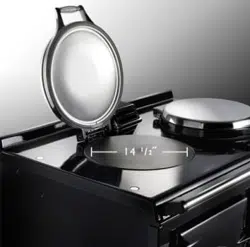Loading ...
Loading ...
Loading ...

29
Range Hoods
It is recommended that this AGA is tted with a range
hood. The AGA venting system is located on top of the
AGA between the two hotplates, and is designed for
venting the moisture from the ovens. The cooker hood
should be positioned not less than the minimum height as
recommended by the manufacturer, from the top of the AGA.
Side Clearances
A
1
⁄8” 3 mm gap is required each side between the range top
plate and adjoining work surfaces that may be tted, this is
to allow for the safe removal of the top plate should this be
required at a later date.
Where ranges are tted against side walls a 4
9
⁄16” (116 mm)
clearance is required on the right and left hand side for oven
doors access.
If the AGA is to be installed in a brick recess, then the
minimum clearance should be increased by at least
3
⁄8” (10
mm), to allow for the walls not being square.
In addition, a minimum clearance of 39
3
⁄8” (1000 mm) must
be available at the front of the range to enable the range to
be serviced.
Tiling
When the range is to stand in a recess or against a wall which
is to be tiled, in no circumstances should the tiles overlap
the range top plate, access to remove the top plate must be
allowed for servicing at a later date.
Rear Wall
A gap of at least
3
⁄8” (10 mm) must be observed from the rear
of the top plate, and the wall behind the appliance.
12. Location
Refer to Fig. 12.1 to Fig. 12.3.
It is recommended that any soft material ooring is removed
from where the AGA will be installed.
It is essential that the base or hearth on which both range
and/or module stands should be level and capable of
supporting the total weight of one or both units.
The front plinth cover is removable and must not be
obstructed by ooring or tiles. If necessary the range must be
raised by the thickness of the tiles to ensure the plinth can be
removed.
Any adjacent walls that project above the height of the hob
must be of heat resistant material.
The side wall above the hob shall be greater than 3” (75 mm)
from the range.
Surfaces over the top of the range must not be closer than
30” (760 mm).
The vent slots in the back of the top plate (or shroud) must
not be obstructed.
NOTE: It is advisable that the supply cable is routed away
from any hot surfaces i.e. hot water/ue pipes.
In the interest of safety, due consideration must be given to
the protection of the electric cable to the range.
If a supply cord is damaged it must be replaced by the
manufacturer, its service agent or similarly qualied
persons in order to avoid a hazard.
The appliance is designed for the voltage stated on the rating
plate, which is situated in the centre vent slot near the base of
the front plate.
DO NOT install the range behind a decorative door
in order to avoid overheating.
The complete range is oor-mounted and the space in
which the appliance is to be tted must have the following
minimum dimensions:-
A minimum clearance of 2
1
⁄4” (60 mm) is required above the
raised insulating cover handle.
Overhead Cabinets
To eliminate the risk of burns or res by reaching
over hot surface units, cabinet storage space located
above the surface units should be avoided.
Minimum Clearance to Combustibles
A gap of at least ½” must be observed between the rear of the
top plate, and the wall behind the appliance. If the rear wall is
of combustible material there must be a gap of 1” (25mm).
This appliance runs continuously, please take note of these
IMPORTANT instructions:
Combustible Walls
Houses constructed of combustible materials (such as all-
timber or stud wall partitions and batoned plasterboarded
walls) require special wall heat protection features.
Non-combustible walls behind a range must be of at least
1” 25 mm thick insulation board (Monolux or equivalent),
up to hotplate level.
NOTE: Ensure electric cabling or plastic services
do not pass within or on the outside of the wall,
behind or directly above the range.
This type of material can age prematurely when exposed to
continuous higher ambient temperature.
Loading ...
Loading ...
Loading ...
